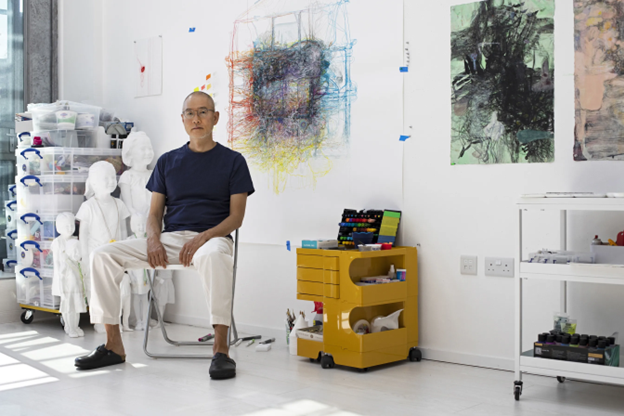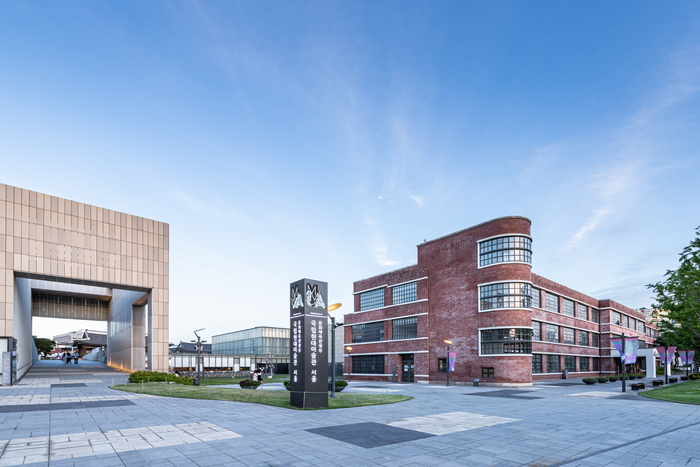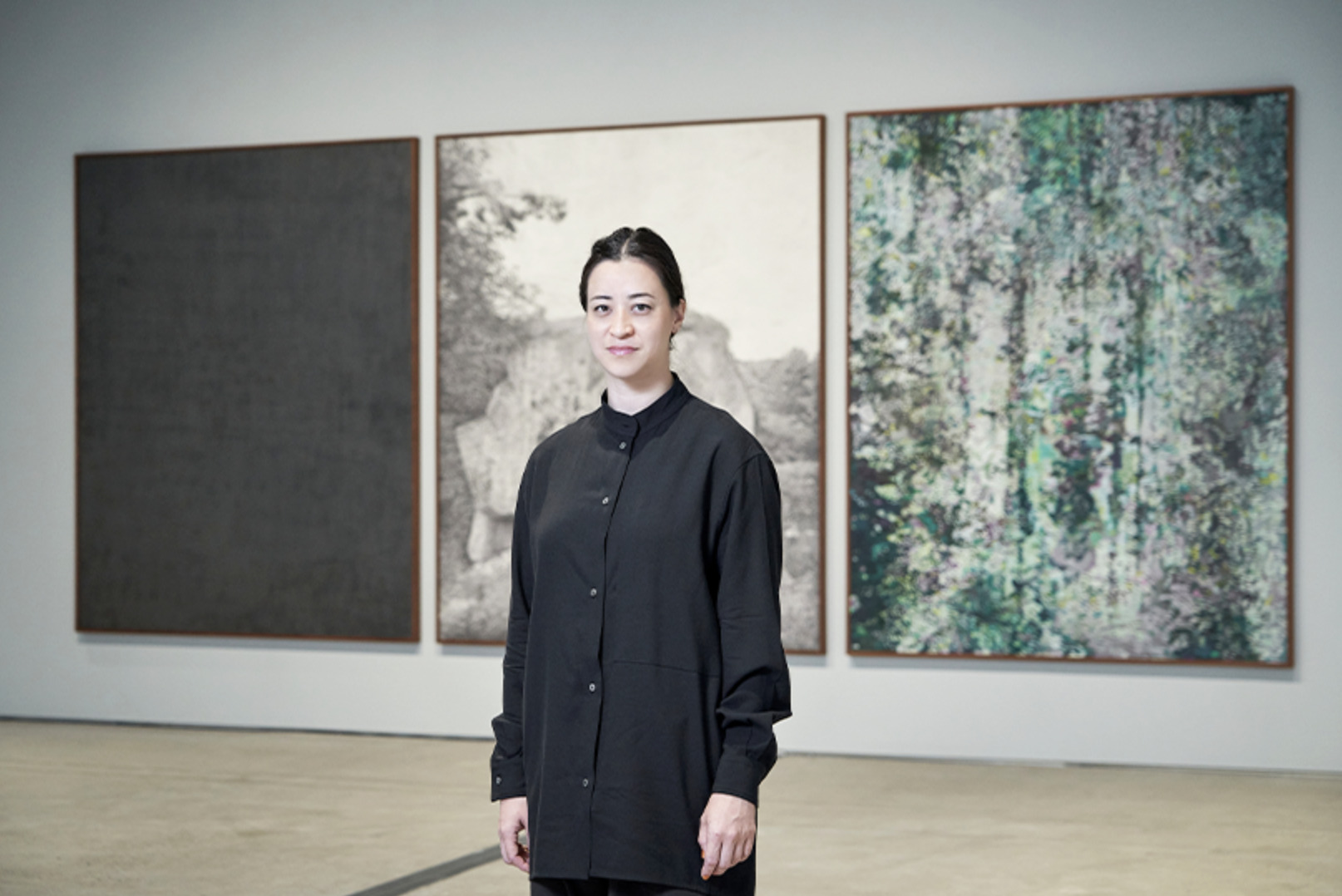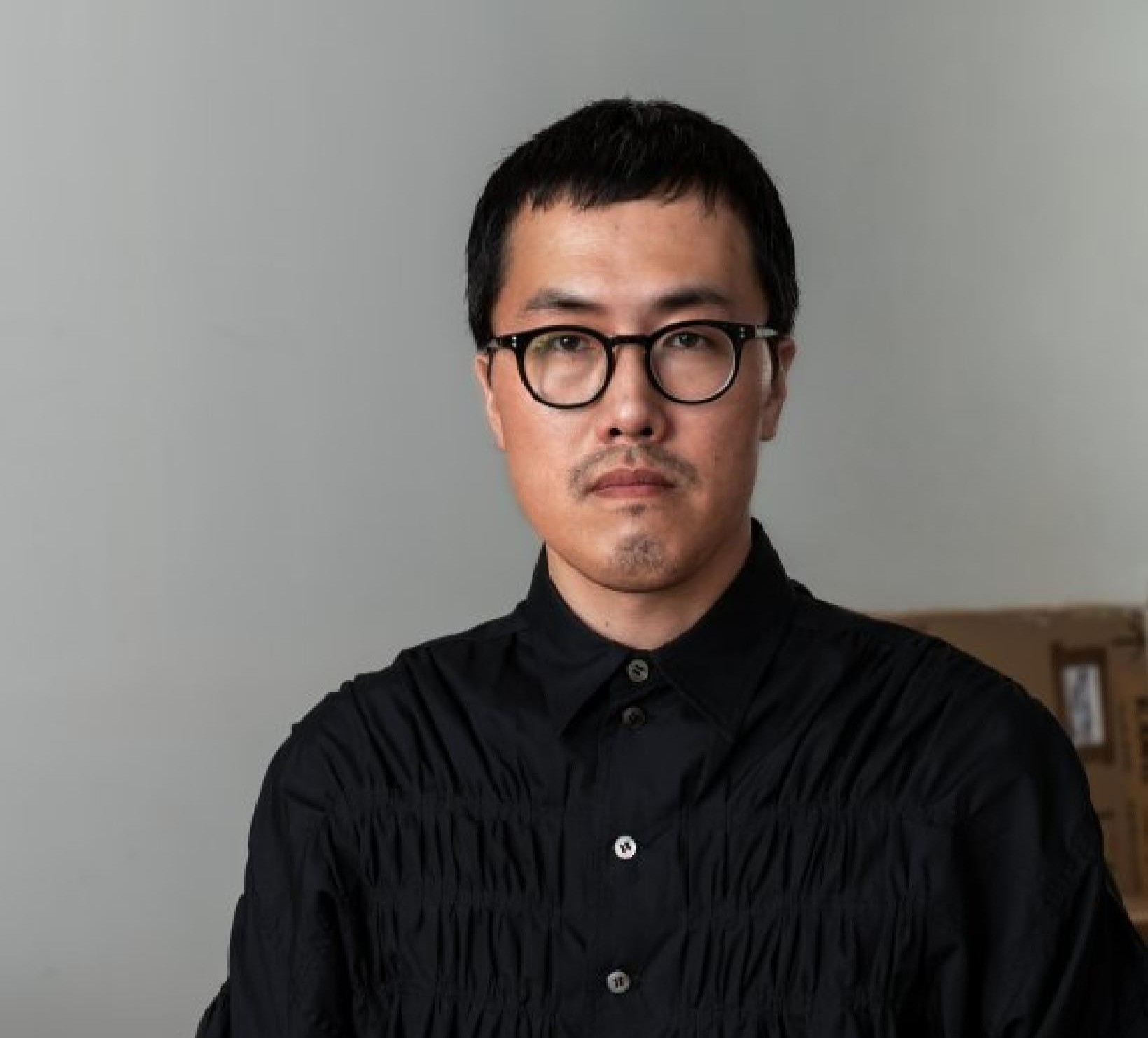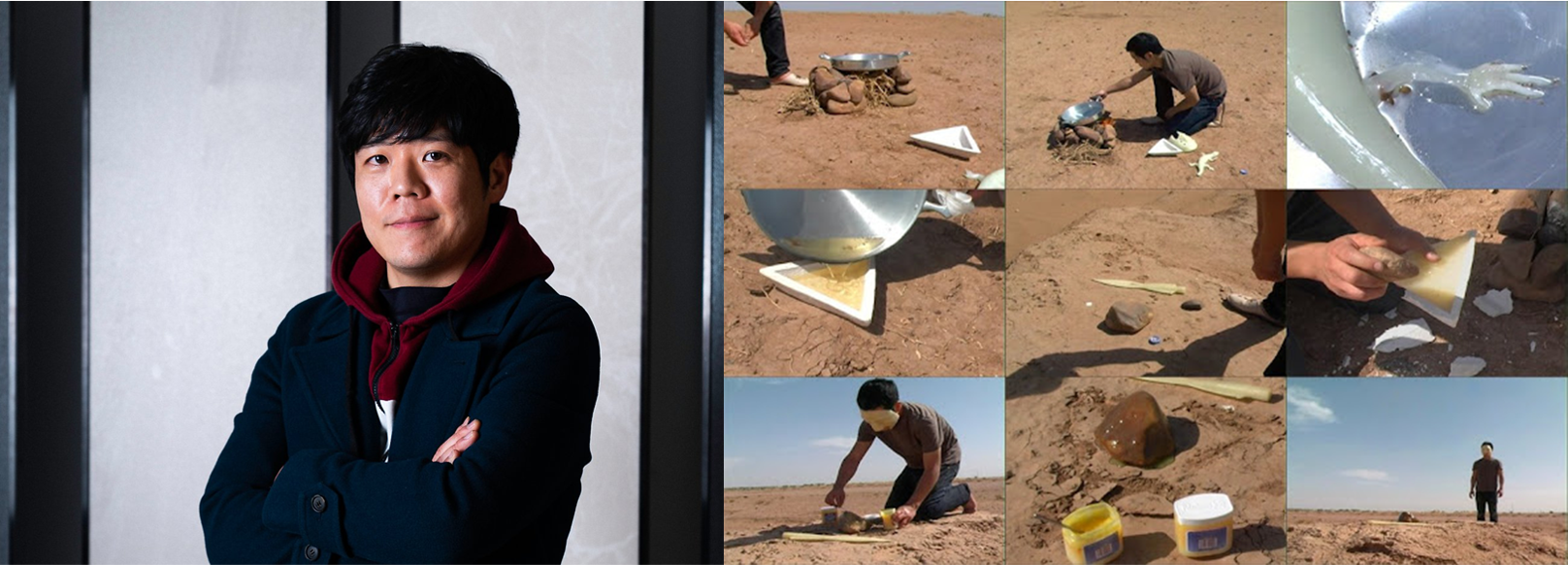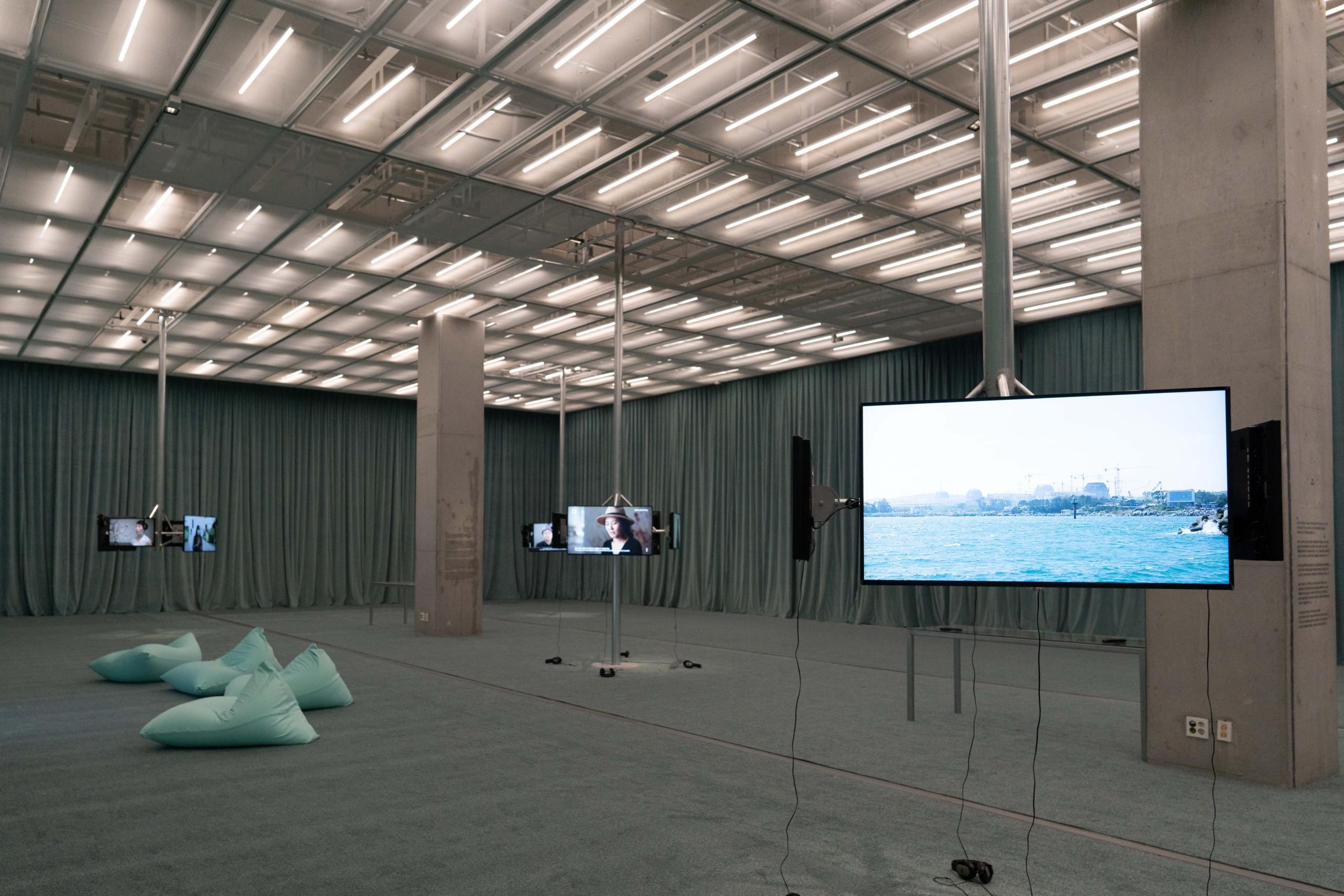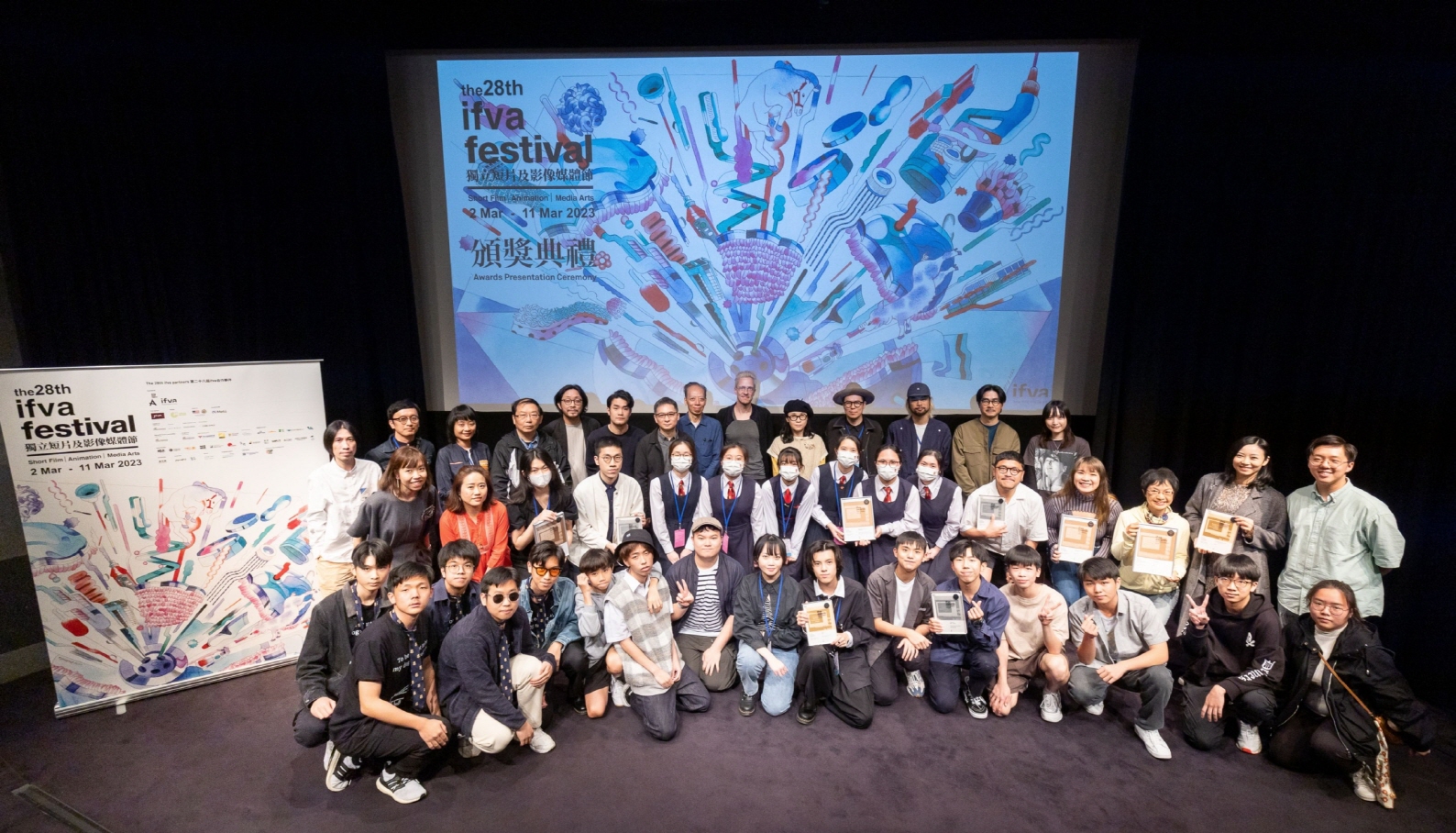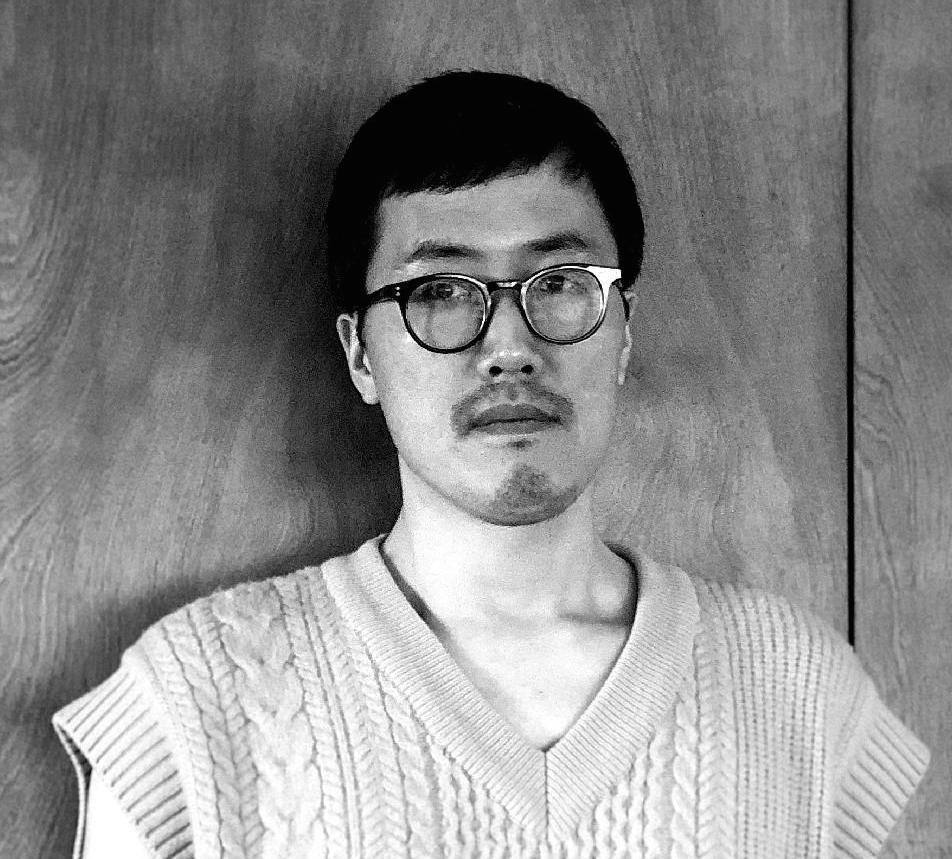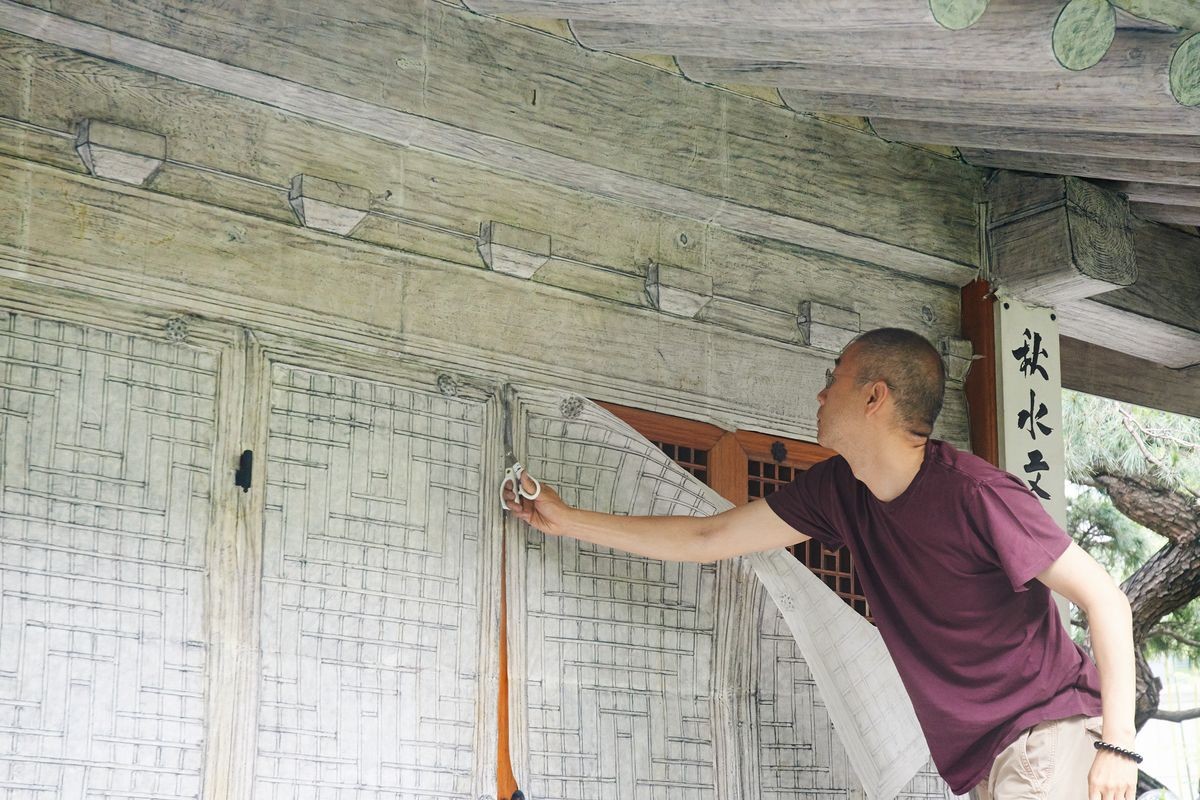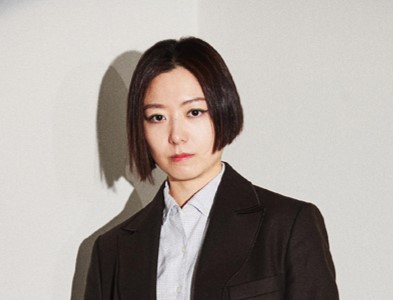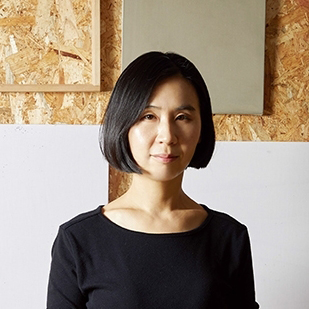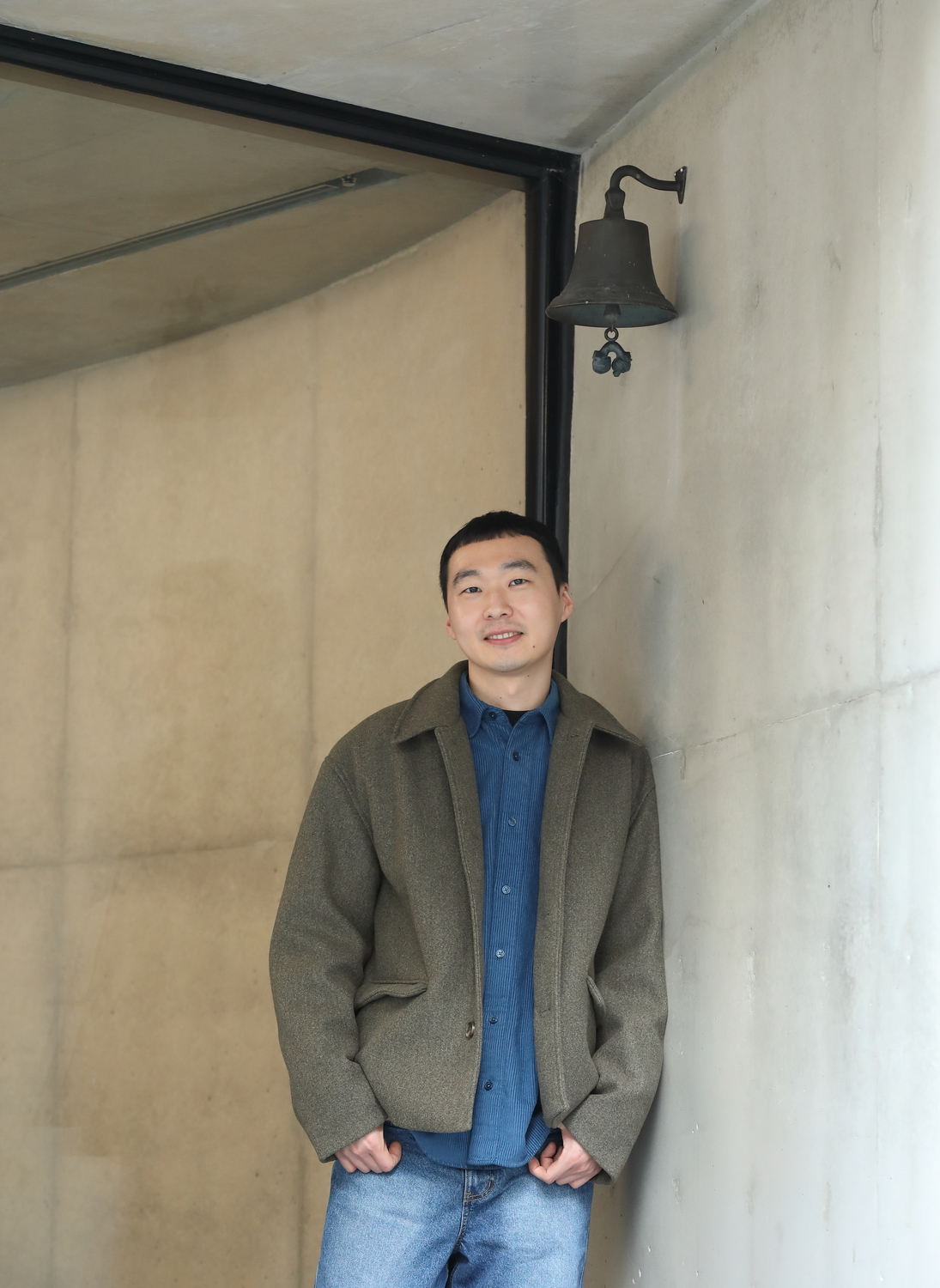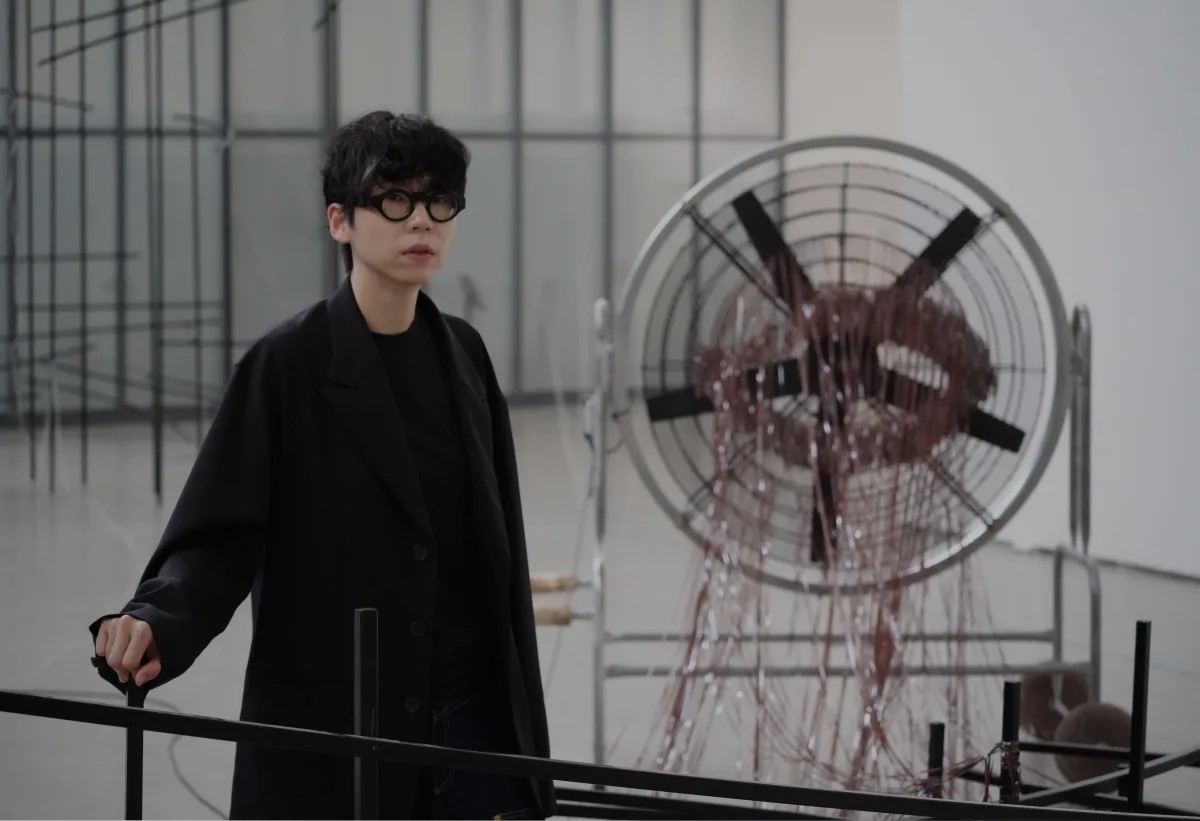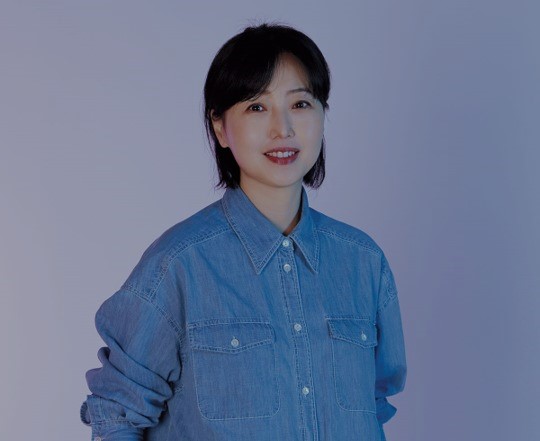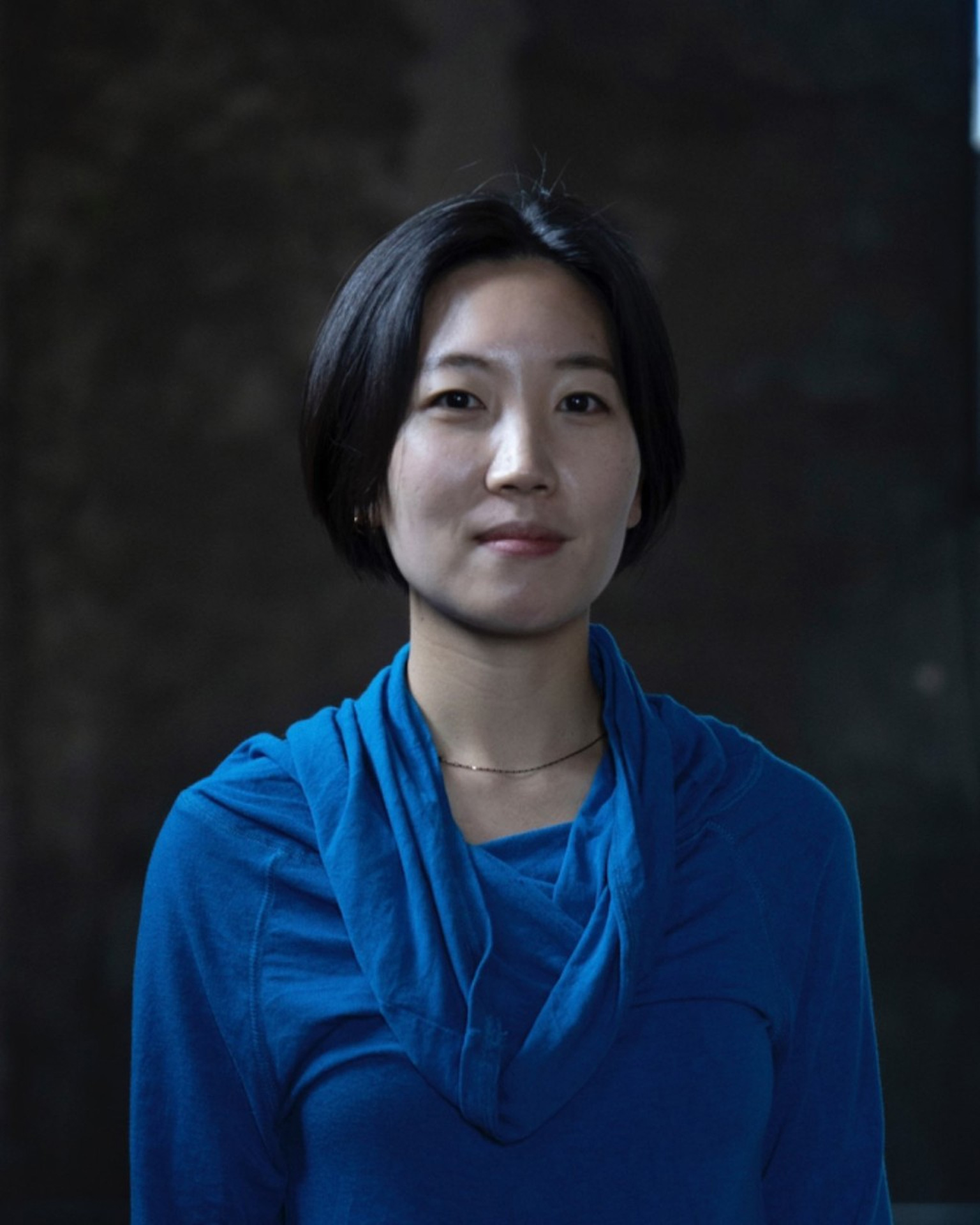Kang Seung Lee (b. 1978), a
multidisciplinary artist, challenges the mainstream history predominantly
centered on the First World, white, male, and heterosexual narratives, while
unveiling the stories of marginalized minorities excluded from this history.
Like a historian, the artist investigates, excavates, and studies public and
private archives.
Lee reappropriates archives of queers
marginalized by the mainstream, transforming them into mediums completed
through his body, such as drawings, embroidery, tapestries, ceramics, textile
sculptures, and neon works. By doing so, he proposes alternative ways to
rewrite and reimagine history.
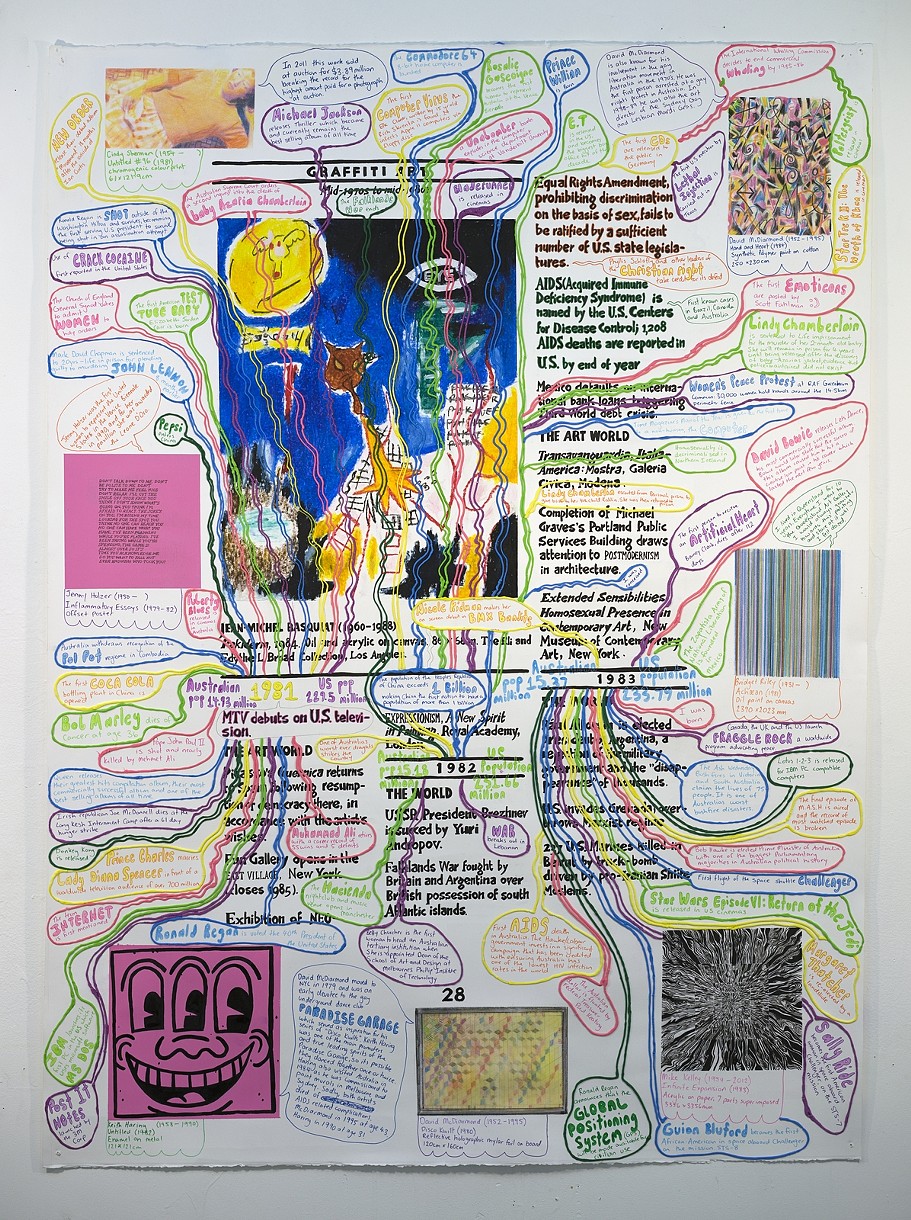 Kang
Seung Lee, Untitled
(Artspeak?)_Alice, 2014-2015 ©Kang Seung Lee
Kang
Seung Lee, Untitled
(Artspeak?)_Alice, 2014-2015 ©Kang Seung LeeA
notable feature of Kang Seung Lee's early works is his practice of inviting
collaborators from diverse backgrounds, including differences in race, sexual
orientation, and origins, to participate in the creation of his art. His
collaboration-based projects unfold as open-ended, ongoing artistic endeavors,
providing his collaborators with opportunities to contribute to the creation of
new narratives while engaging in further learning experiences.
This
collaborative structure began with his early project Untitled
(Artspeak?) (2014–). Kang Seung Lee invited 20 fellow artists he knew
in the U.S. at the time to collaborate. He provided each collaborator with a
hand-drawn, enlarged copy of the page from Robert Atkins' book Artspeak:
A Guide to Contemporary Ideas, Movements, and Buzzwords, 1945 to the Present
corresponding to their birth year and asked them to edit it.
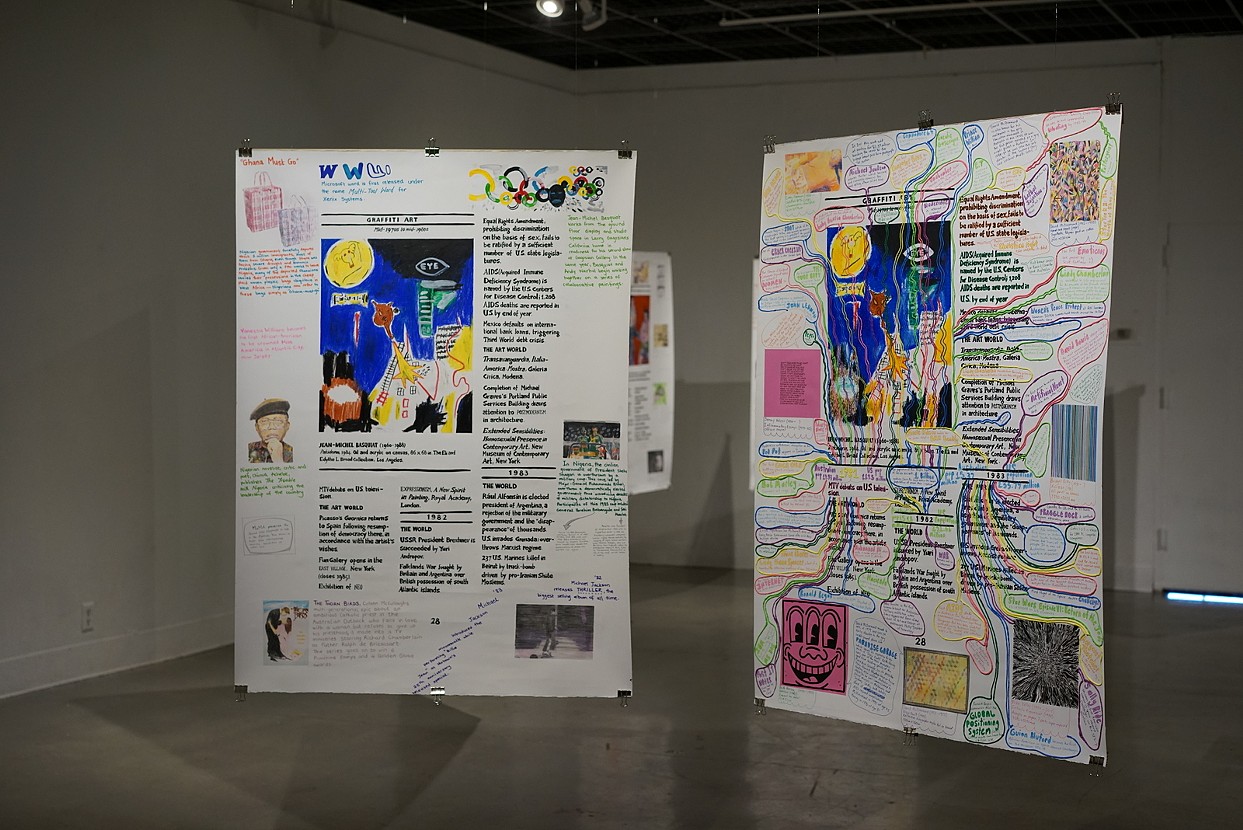 Kang
Seung Lee,
Untitled (Artspeak?), 2014-2015, Installation view ©Kang Seung Lee
Kang
Seung Lee,
Untitled (Artspeak?), 2014-2015, Installation view ©Kang Seung LeeThese
collaborators, who represented a variety of ages, genders, races, sexual
orientations, and cultural backgrounds, filled the margins of the pages with annotations,
anecdotes, events, and drawings related to works, musicians, and filmmakers
omitted from the original text.
The
resulting edited pages collectively recorded a multi-layered historical
narrative intersecting diverse individual experiences, deconstructing the
male-centric, heteronormative, and colonialist perspectives embedded in the
original history of the book.
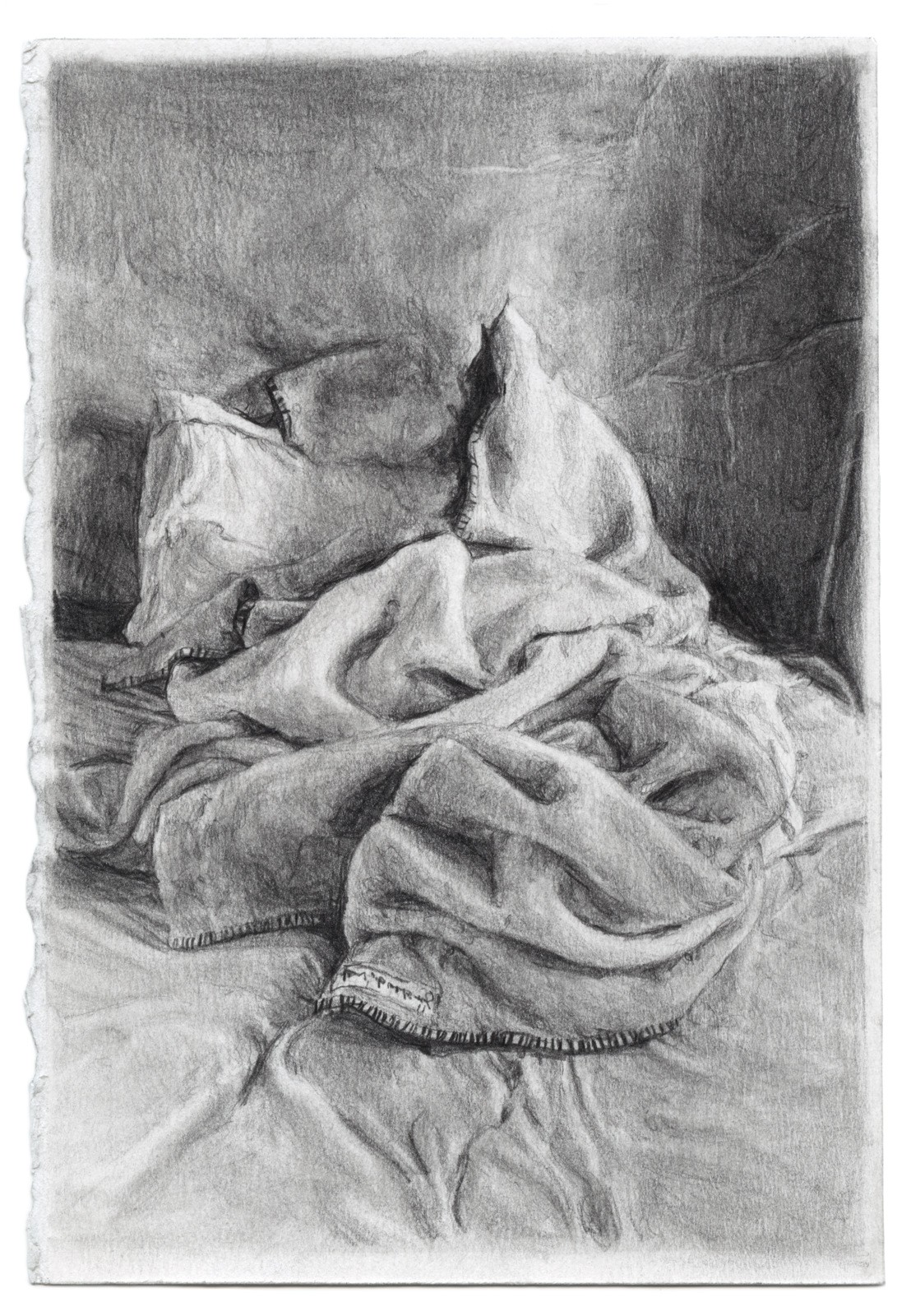 Kang
Seung Lee,
Untitled (David Wojnarowicz by Peter Hujar_1983), 2016 ©Kang Seung Lee
Kang
Seung Lee,
Untitled (David Wojnarowicz by Peter Hujar_1983), 2016 ©Kang Seung LeeMeanwhile,
in his 2016 solo exhibition “Absence without leave” at Commonwealth and Council
in Los Angeles, Lee presented a series of graphite drawings that memorialize
and document the lives of queer individuals who lived brief lives.
Lee’s
drawings are based on photographs depicting gay men in the 1970s and 1980s
America, including Robert Mapplethorpe’s self-portraits and Peter Hujar’s
portrait of David Wojnarowicz. While faithfully replicating the source
photographs, Lee erased or rendered the human figures indistinct.
This
absence of figures suggests the anxiety and despair brought about by the AIDS
epidemic, which spread across the United States and the world, as well as the
societal and governmental denial of the disease’s existence at the time.
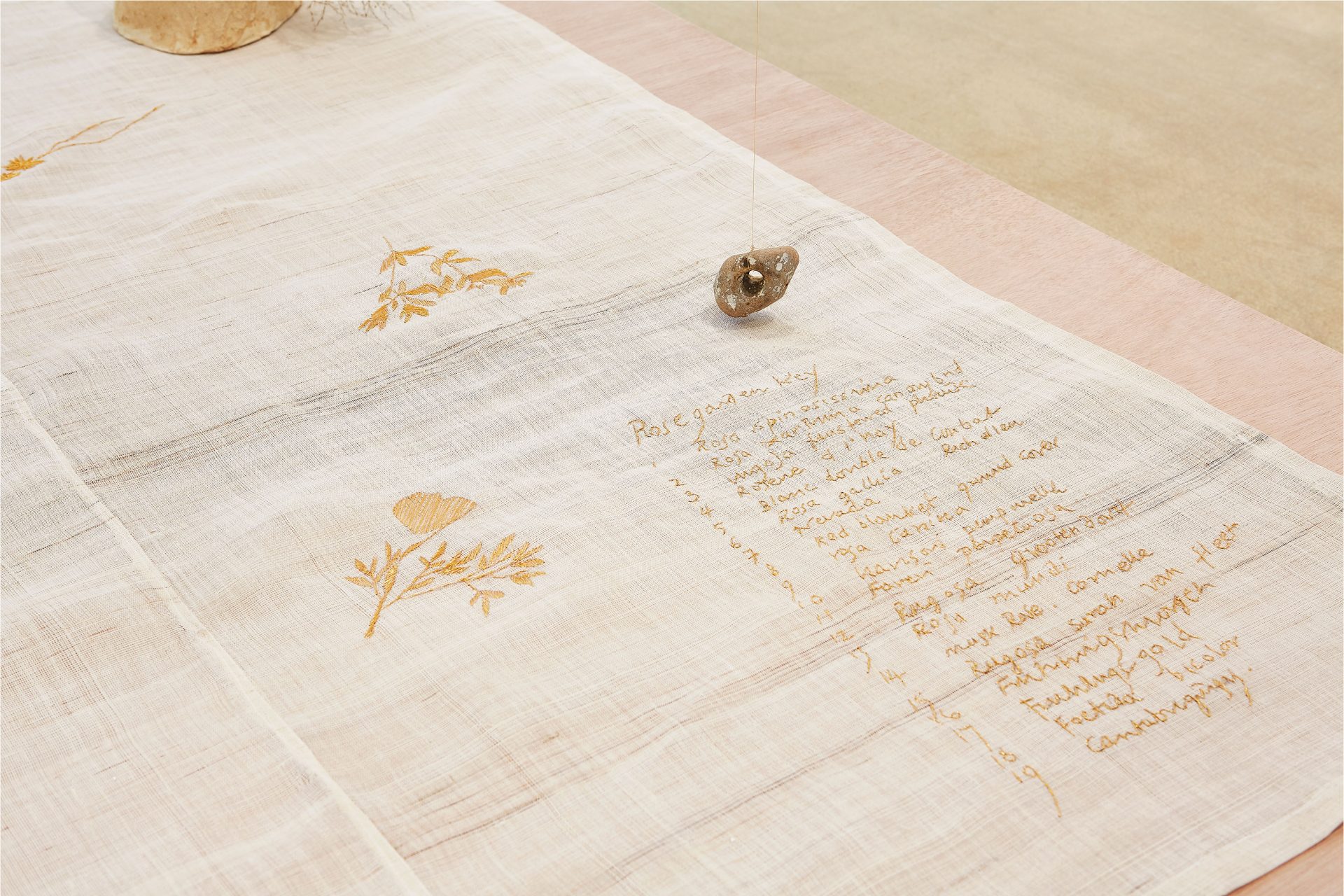 Kang Seung
Lee, Untitled (Garden), 2018, Installation
view of “Garden” (ONE AND J. Gallery, 2018) ©ONE AND J. Gallery
Kang Seung
Lee, Untitled (Garden), 2018, Installation
view of “Garden” (ONE AND J. Gallery, 2018) ©ONE AND J. GalleryThe
following year, Kang Seung Lee held his first solo exhibition in Korea. The
2018 exhibition “Garden” at ONE AND J. Gallery was composed of drawings,
installations, and video works that commemorated and documented the lives of
Derek Jarman and Joon-soo Oh. Both were gay rights activists in the 1990s who
passed away from AIDS-related complications—Jarman in the UK and Oh in
Korea.
Starting
two years prior to the exhibition, Lee made multiple visits to Derek Jarman’s
personal garden, collecting plants that Jarman had personally selected and
arranged, while recreating traces left behind in the garden. As a way to
remember and record Jarman, Lee embroidered the plants, garden sculptures, and
excerpts from Jarman’s diary—along with his handwriting—onto traditional Korean
hemp fabric using gold thread.
This
performative act of documentation through the artist’s body transforms Derek
Jarman’s life, marked by his fight against the social stigma of AIDS and
homophobia, into an intensely powerful and noble memory.
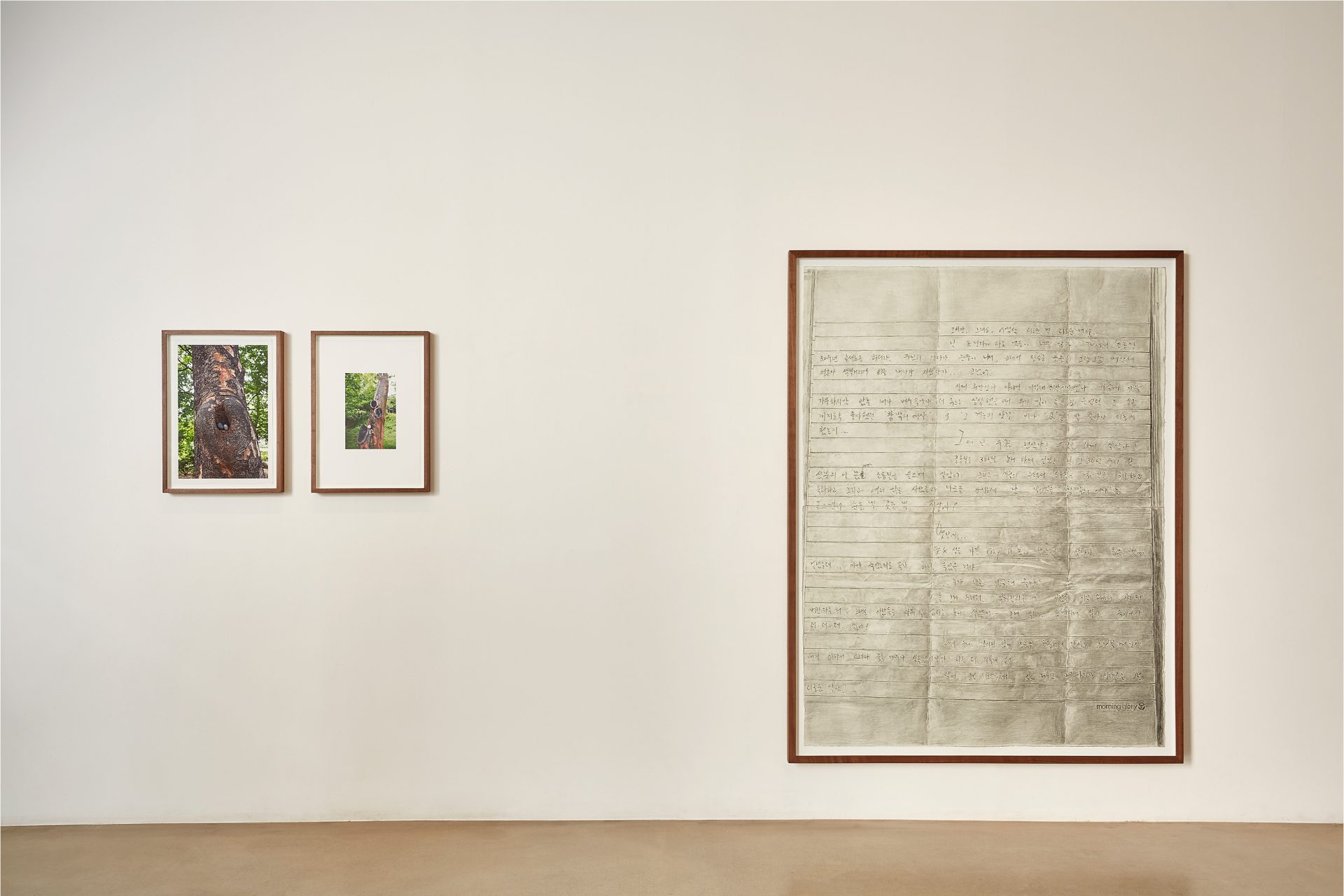 Left to Right; Kang Seung
Lee, Untitled (Tree at Tapgol Park and pebbles from
Dungeness), Untitled (Tree at Namsan Park and a pebble from Dungeness),
Untitled (Joon-soo Oh's Letter), 2018, Installation view of “Garden”
(ONE AND J. Gallery, 2018) ©ONE AND J. Gallery
Left to Right; Kang Seung
Lee, Untitled (Tree at Tapgol Park and pebbles from
Dungeness), Untitled (Tree at Namsan Park and a pebble from Dungeness),
Untitled (Joon-soo Oh's Letter), 2018, Installation view of “Garden”
(ONE AND J. Gallery, 2018) ©ONE AND J. GalleryAlongside this, Kang Seung Lee brought the
life of Joon-soo Oh—a Korean gay rights and AIDS activist who passed away at a
young age—into historical focus as a narrative that must be recorded and
shared. The artist recreated materials related to Oh, including records of his
activism with the gay rights organization “Chingusai” ("Between
Friends"), letters exchanged with friends, and his diaries and poems
published posthumously by his friends, through drawings and embroidery works.
The 160 x 120 cm drawing Untitled
(Joon-soo Oh's Letter) (2018) features an enlarged reproduction of a
letter in which Joon-soo Oh expressed the loneliness he felt imagining his own
death from AIDS. Lee meticulously recreated Oh’s handwriting and even the
creases of the paper. Unlike his earlier smaller-scale drawings, this piece is
monumental in size, displayed vertically like a memorial. By inviting viewers
to slowly read and contemplate the work, Lee re-inscribed Joon-soo Oh’s life
into the collective memory of contemporary audiences.
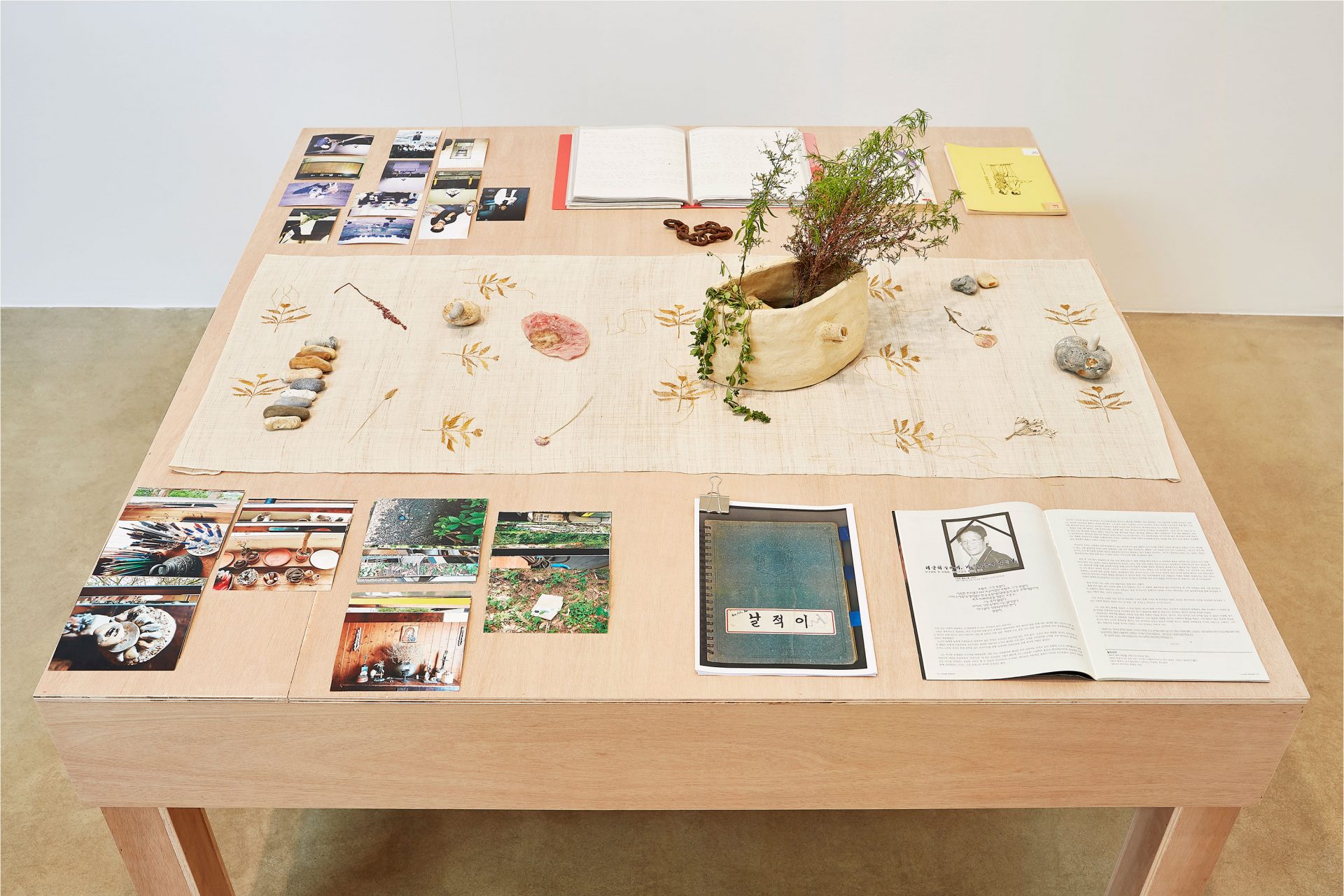 Installation view
of “Garden” (ONE AND J. Gallery, 2018) ©ONE AND J. Gallery
Installation view
of “Garden” (ONE AND J. Gallery, 2018) ©ONE AND J. GalleryIn this way, Kang Seung Lee laboriously recreated the lives of two individuals who lived in different parts of the world, memorializing and recording their lives of constant resistance as history through meticulous, labor-intensive media. The exhibition wove together collected materials and objects gathered by following the trajectories of their lives in two disparate locations. By intersecting and connecting their parallel struggles, acts of creation, and resistance, the exhibition became a space of remembrance and homage.
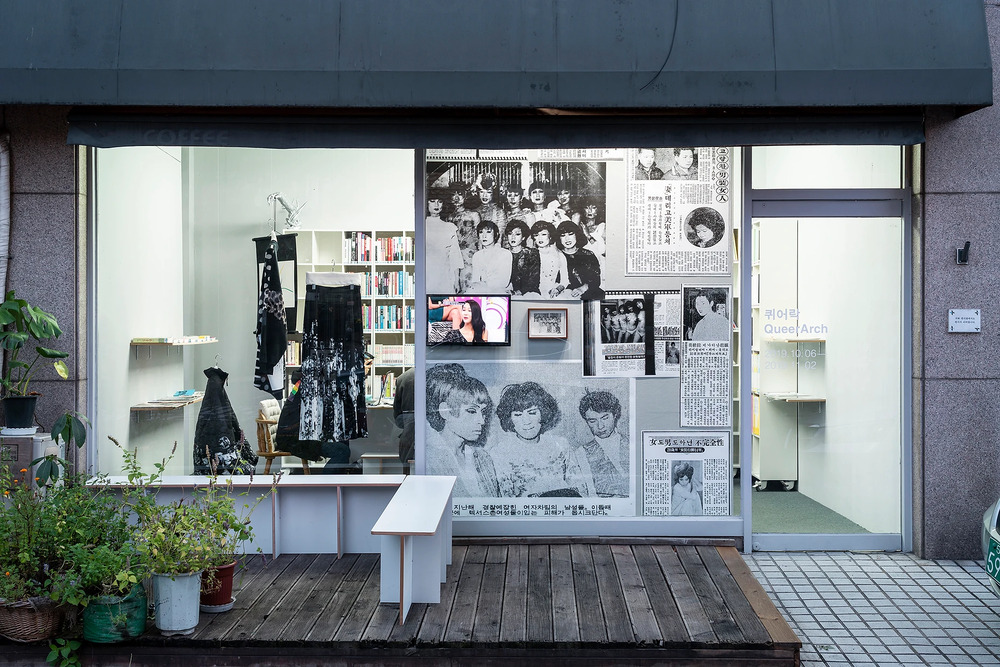 Installation view
of “QueerArch” (Hapjungjigu, 2019) ©Hapjungjigu
Installation view
of “QueerArch” (Hapjungjigu, 2019) ©HapjungjiguIn 2019, Kang Seung Lee curated an
exhibition with young Korean queer artists in their twenties and thirties,
reimagining a timeline of Korean queers erased from history. Titled
"QueerArch," the exhibition was held at Hapjungjigu and began with
the personal archive of Hahn Chae Yoon, an activist at “QueerArch” (Korean
Queer Archive, established in 2002) and the editor-in-chief of the Korean queer
magazine “Buddy” (1998–2003), along with donated materials from the magazine.
Based on months of research conducted at
QueerArch, Lee and the participating artists developed a creative and
alternative timeline expressed through graphic design, sculpture, installation,
video, and fashion. In this project, Lee took on multiple roles as an artist,
curator, and exhibition director.
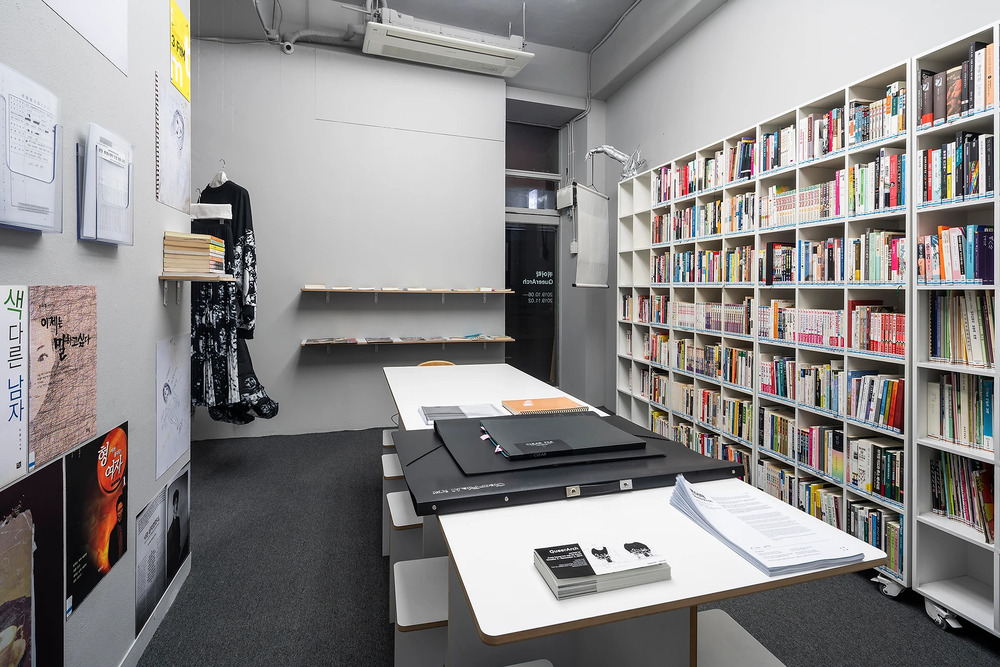 Installation view
of “QueerArch” (Hapjungjigu, 2019) ©Hapjungjigu
Installation view
of “QueerArch” (Hapjungjigu, 2019) ©HapjungjiguThis temporary queer community, shaped
through Kang Seung Lee's curatorial practice, included fashion designer Kim Se
Hyung (a.k.a. AJO), archivist and researcher Ruin, artist and stage director
Moon Sang Hoon, drag king Azangman, visual designer Kyungmin Lee, and sculptor
Haneyl Choi.
Through this collaborative exhibition, Lee
sought not only to rewrite a history dedicated to the activist legacy of queer
communities but also to illuminate the contours of a collective that has
continuously sought connection and solidarity to resist isolation in times of
crisis.
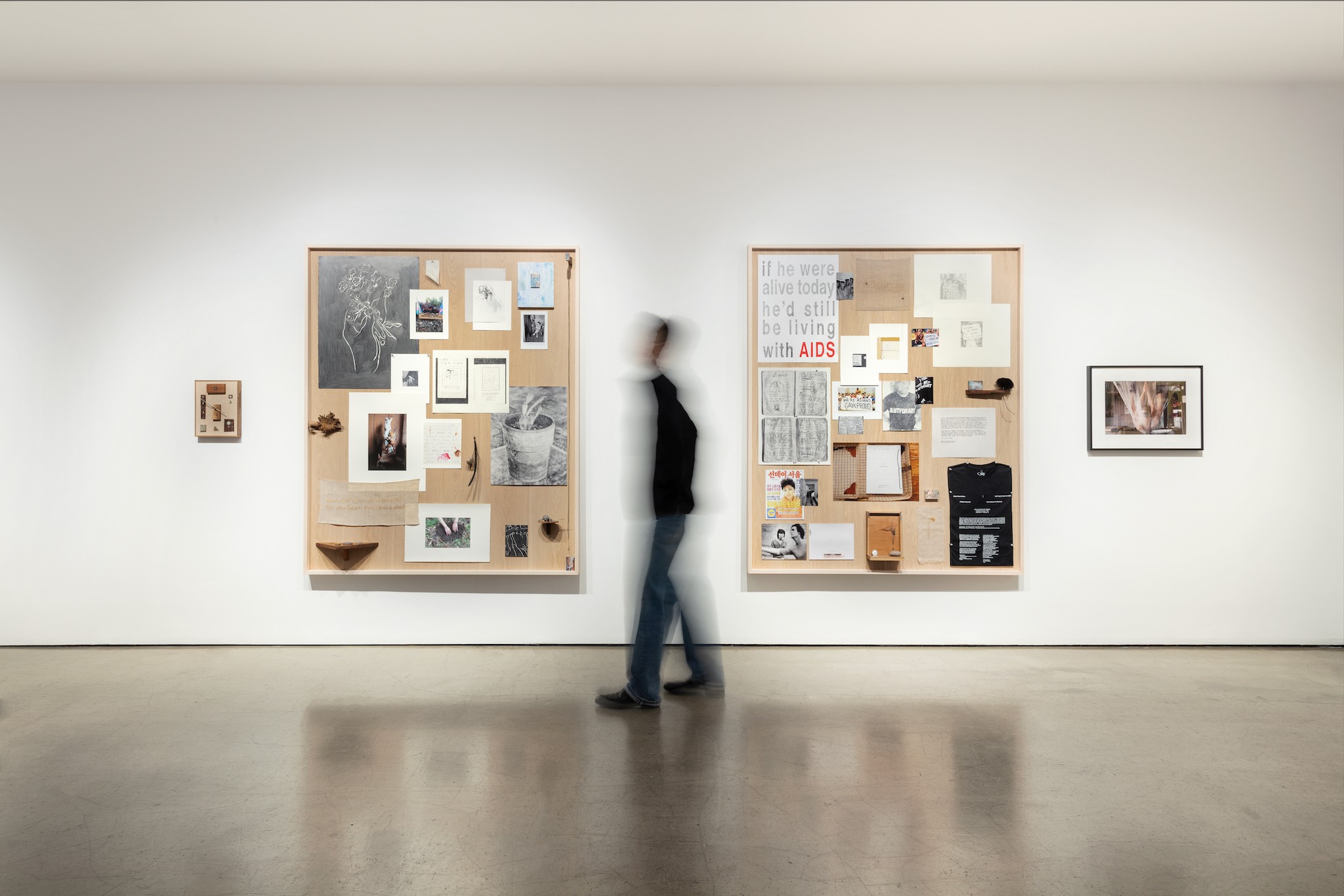 Installation
view of “Briefly Gorgeous” (Gallery Hyundai, 2021) ©Kang Seung Lee
Installation
view of “Briefly Gorgeous” (Gallery Hyundai, 2021) ©Kang Seung LeeIn 2020, with the global disaster caused by
the COVID-19 pandemic, discrimination and hatred, which were already pervasive
in everyday life, spread simultaneously. Vulnerable places and groups, which
were the most susceptible to the spread, became the primary targets, and groups
such as migrants and LGBTQ+ individuals, who were the most vulnerable and in
need of community, became the subjects of public condemnation and hatred. At
the same time, in the West, hatred and discrimination against Asian people intensified
in various places, and in Korea, the news of consecutive transgender suicides
was reported.
In the 2021 solo exhibition "Briefly
Gorgeous" at Gallery Hyundai, Lee presented an archive as a form of
practice that connected the past history of the queer community with queer
individuals in the midst of contemporary crises.
In the exhibition, the artist invoked Asian
artists, such as Hong Kong-born photographer Tseng Kwong Chi and Singaporean
dancer Goh Choo San, who gained fame with the Washington Ballet in the 1980s,
among artists who died or survived from AIDS, a pandemic that has crossed the
history of LGBTQ+ individuals even before the COVID-19 pandemic.
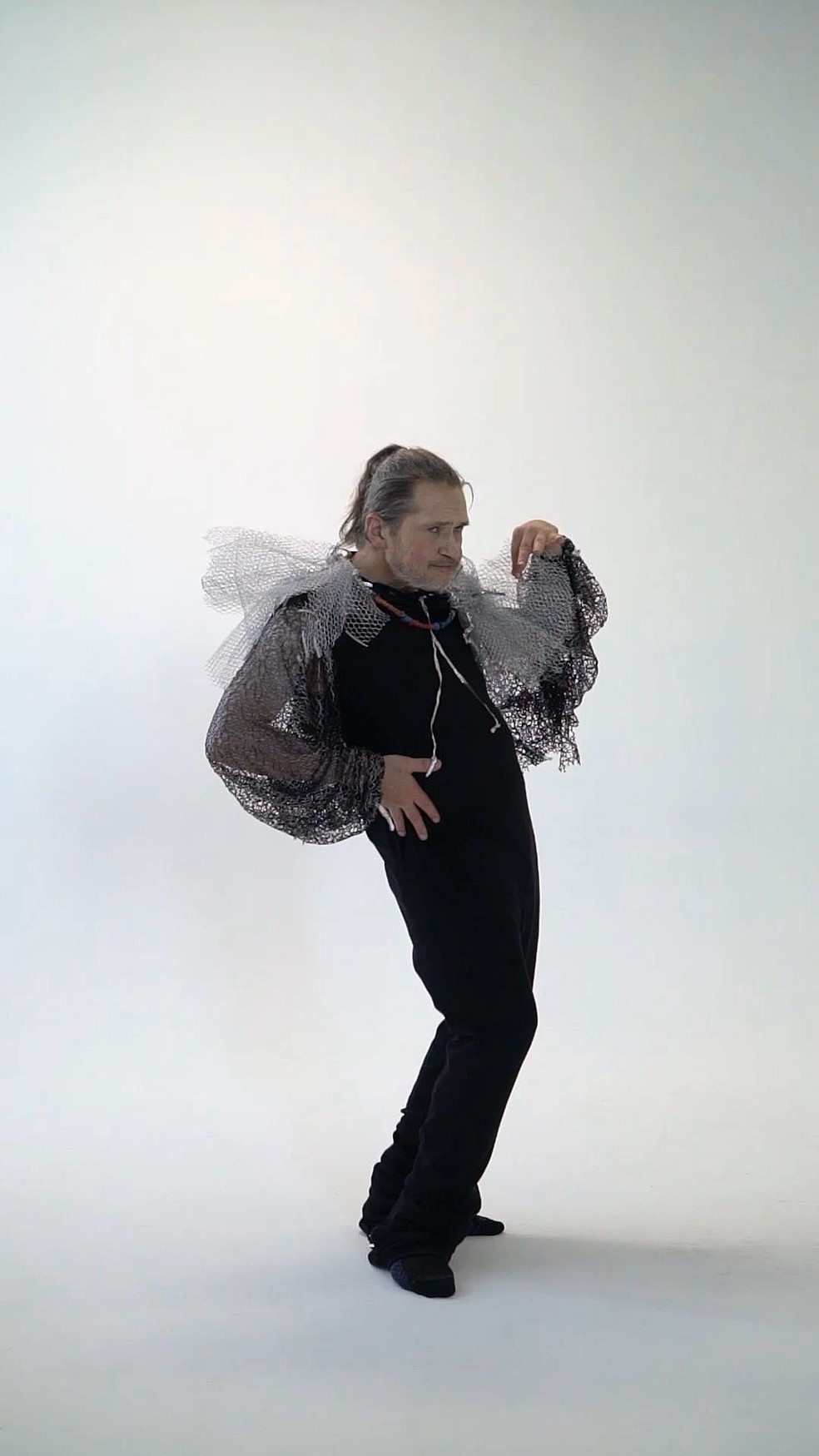 Kang Seung
Lee, Untitled (Shawn McQuate), 2021 ©Kang Seung Lee
Kang Seung
Lee, Untitled (Shawn McQuate), 2021 ©Kang Seung LeeThe video work Untitled (Shawn
McQuate) (2021) documents the process of recreating a 1980 poster
work by Tseng Kwong Chi, in collaboration with ballet dancer Shawn McQuate, who
was the model for the original poster. Despite losing his sight due to
HIV-related complications, McQuate painstakingly posed in the recreated costume
after 41 years to reproduce the original poster.
Additionally, the artist created drawings
of Kim Ki-hong, a transgender activist and music teacher in Korea who passed
away in early 2021, and Byun Hee-soo, a soldier who was forcibly discharged
from the army due to undergoing gender confirmation surgery. The artist also
sensually arranged various images, texts, and objects as fragments of different
times, spaces, and contexts.
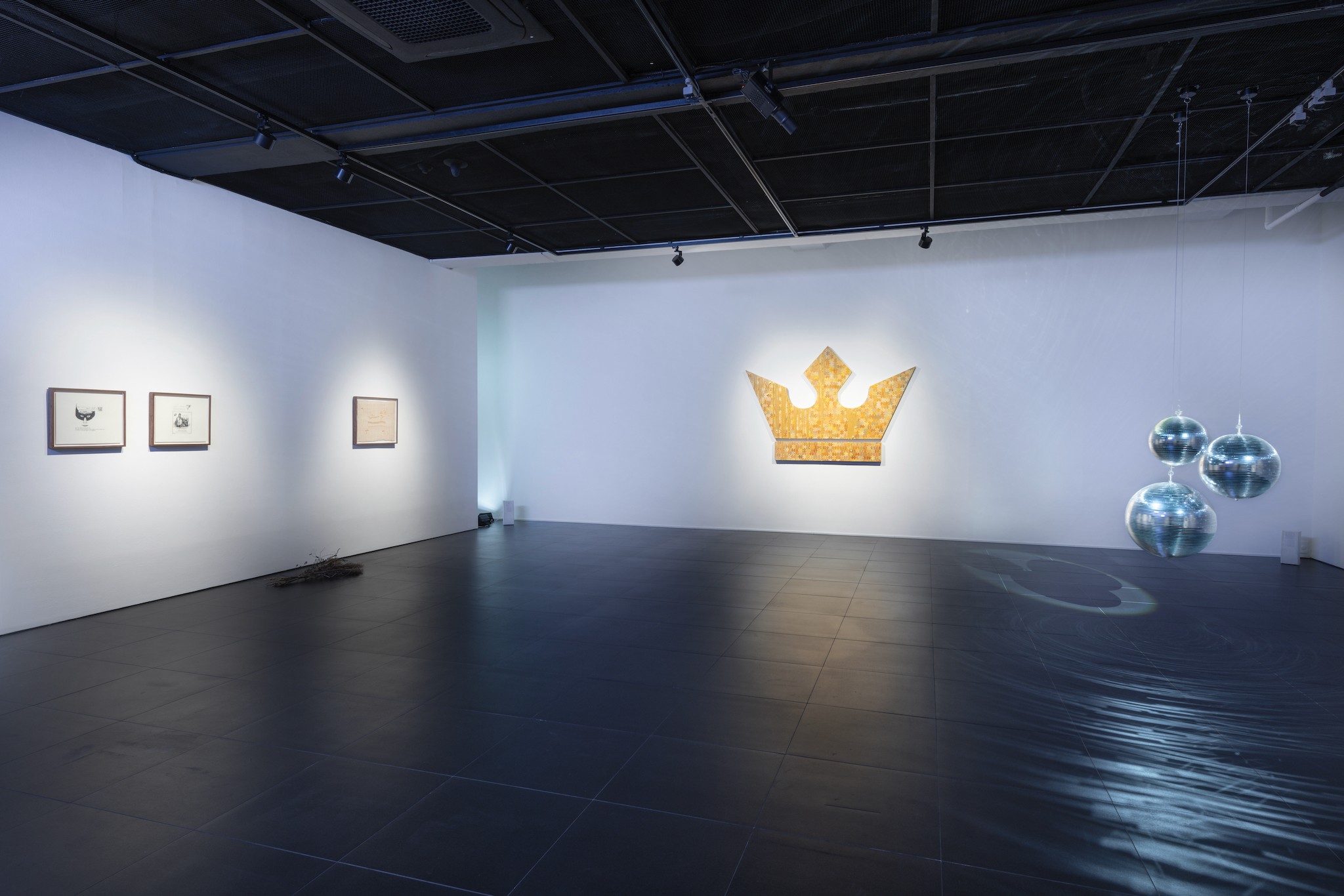 Installation
view of Briefly Gorgeous” (Gallery Hyundai, 2021) ©Kang Seung Lee
Installation
view of Briefly Gorgeous” (Gallery Hyundai, 2021) ©Kang Seung LeeIn the basement exhibition space, the logo
of the “King Club,” a gay club in Itaewon that became a target during the
spread of COVID-19, was assembled into a puzzle and hung on the wall. The
club's lighting was set up, and then the individual playlists created by fellow
artists, who interpreted the meaning of queer spaces, were played.
In this way, the exhibition space flexibly
transformed into a queer museum, archive, and club—spaces that hold the
memories, experiences, and narratives of the queer community.
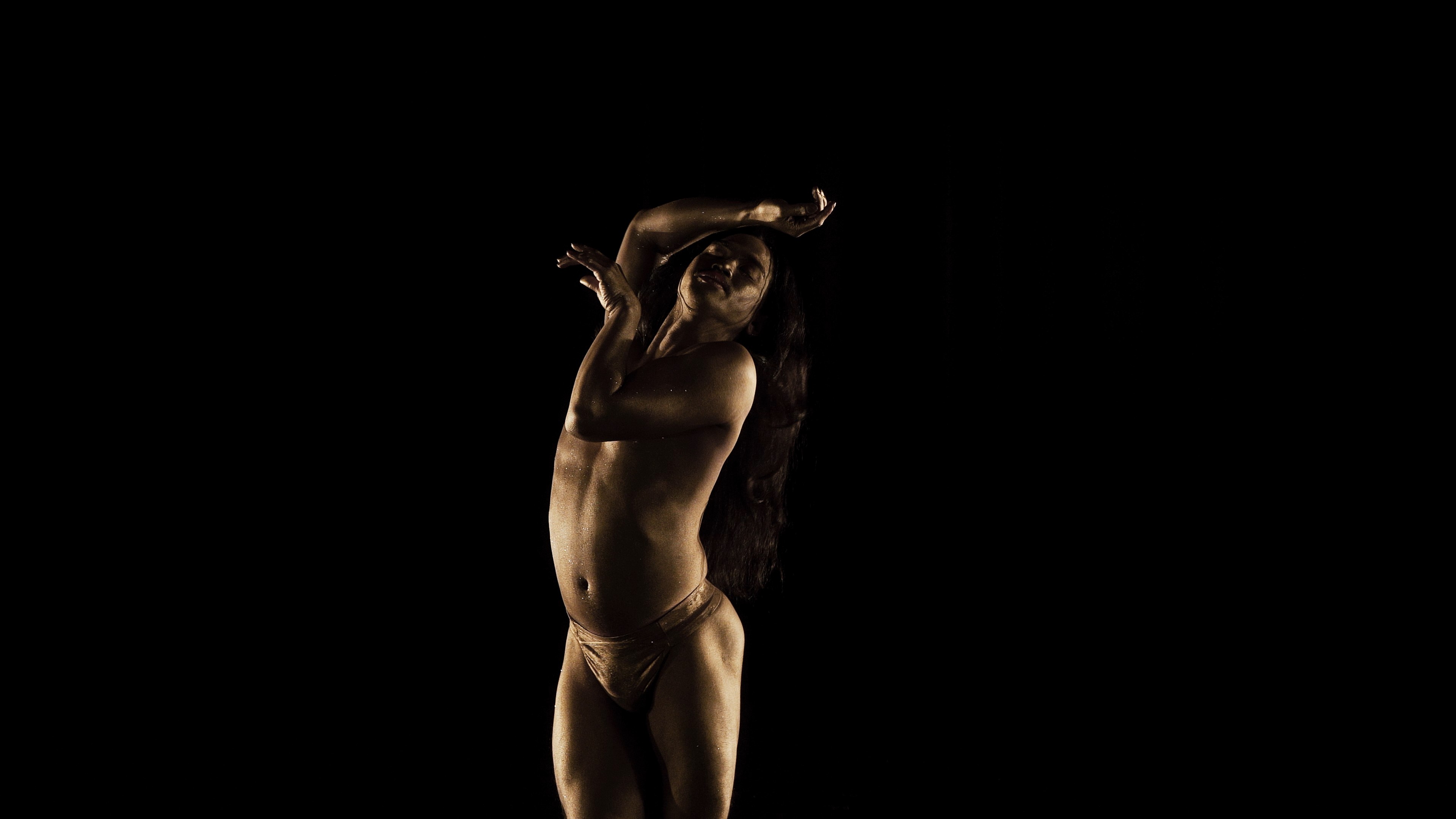 Kang Seung
Lee, The Heart of A Hand, 2023 ©Kang Seung Lee
Kang Seung
Lee, The Heart of A Hand, 2023 ©Kang Seung LeeHis new work The Heart of A Hand
(2023), presented at the National Museum of Modern and Contemporary Art Korea's
“Korea Artist Prize 2023” exhibition, reexamines the life of Goh Choo San, a
Singaporean choreographer and dancer who passed away at a young age due to
AIDS-related complications.
Goh Choo San was a choreographer and
artistic director for the Washington Ballet and collaborated actively with
major American ballet companies such as the American Ballet Theatre and Houston
Ballet. However, his history and achievements have largely been erased from
both mainstream American art history and queer history.
Kang Seung Lee sought to remember and
rewrite his life and legacy by collaborating with queer community members,
including Filipino transgender and non-binary choreographer Joshua Serafin,
filmmaker Nathan Mercury Kim, and Seoul-based transgender composer KIRARA. This
collaboration resulted in the video work The Heart of A Hand.
The video is based on Goh Choo San's
choreography Configurations (1981). In this, choreographer
Joshua Serafin reinterprets the original choreography by mixing classical
ballet, contemporary dance, and nightclub-style movements. Serafin's
choreography is accompanied by intense EDM tracks, creating a feeling that distances
it from the original work.
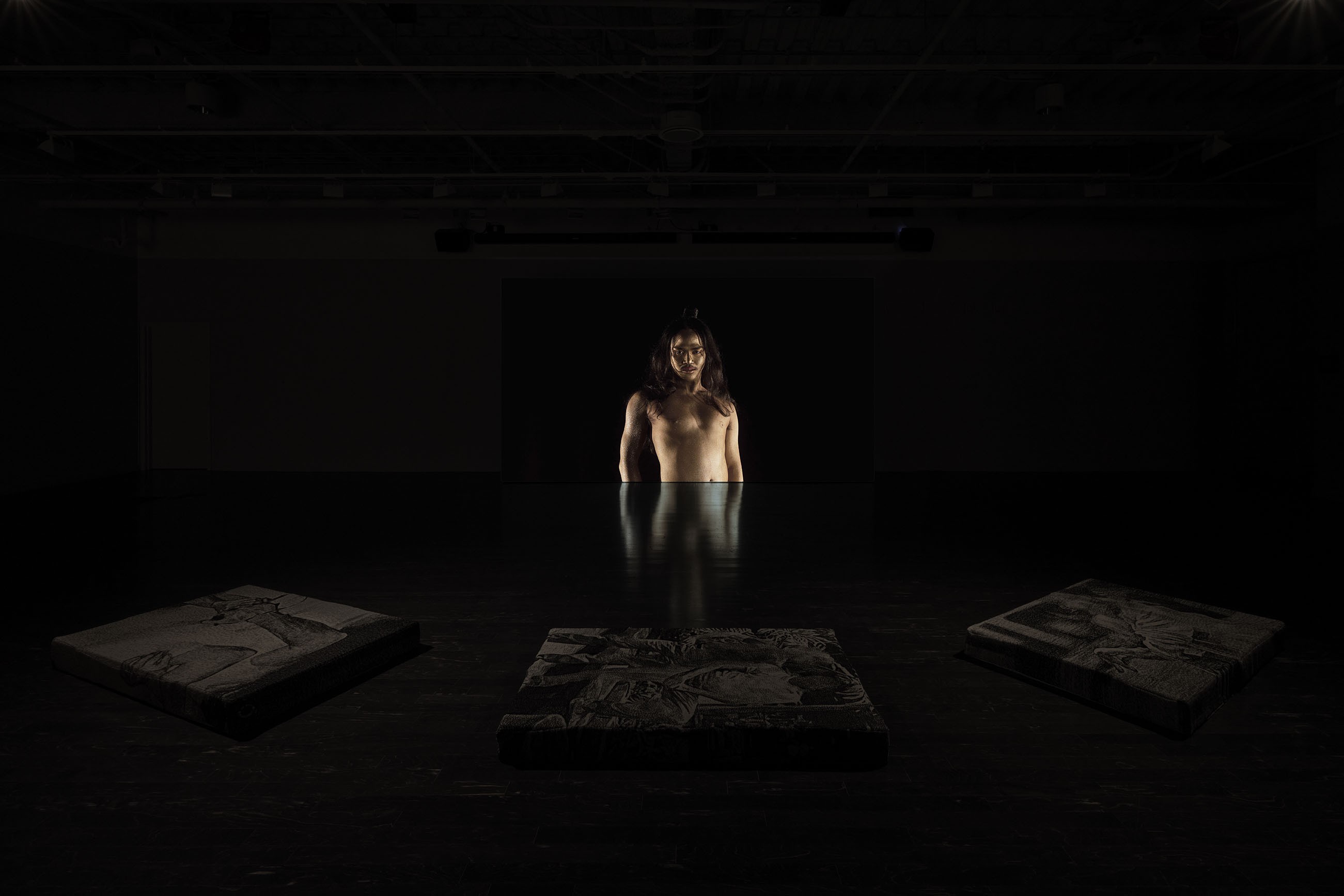 Kang Seung
Lee, The Heart of A Hand, 2023, Installation
view at Vincent Price Art Museum in LA (2023) ©Kang Seung
Lee
Kang Seung
Lee, The Heart of A Hand, 2023, Installation
view at Vincent Price Art Museum in LA (2023) ©Kang Seung
LeeSerafin's fluid movements and pulsating
sound not only express the achievements left by Goh Choo San but also
deconstruct his choreography, presenting a new imagination for the future of
queerness that transcends regions, nationalities, and generations.
In this way, Kang Seung Lee questions a
reality where those who existed but remained hidden are erased and continues a
"care" practice by resurrecting the erased narratives of individuals.
By doing so, he connects these people across time, borders, races, and genders.
To this end, the artist has gathered fellow queer artists and activists to
collectively engage in the rewriting of history, leaving behind stories that
will be passed down to future generations.
”I would like my work to question the
erasure of others who came before and remain unseen, to generate conversations
about the space that holds intergenerational connections and care, and to be an
invitation to reimagine invisibility as potentiality.” (Kang Seung Lee, “Kang
Seung Lee on Tseng Kwong Chi”, in Denise Tsui, ed., Collected Writings by
Artists on Artists vol. 2 (CoBo Social, 2021), pp. 96–103.))
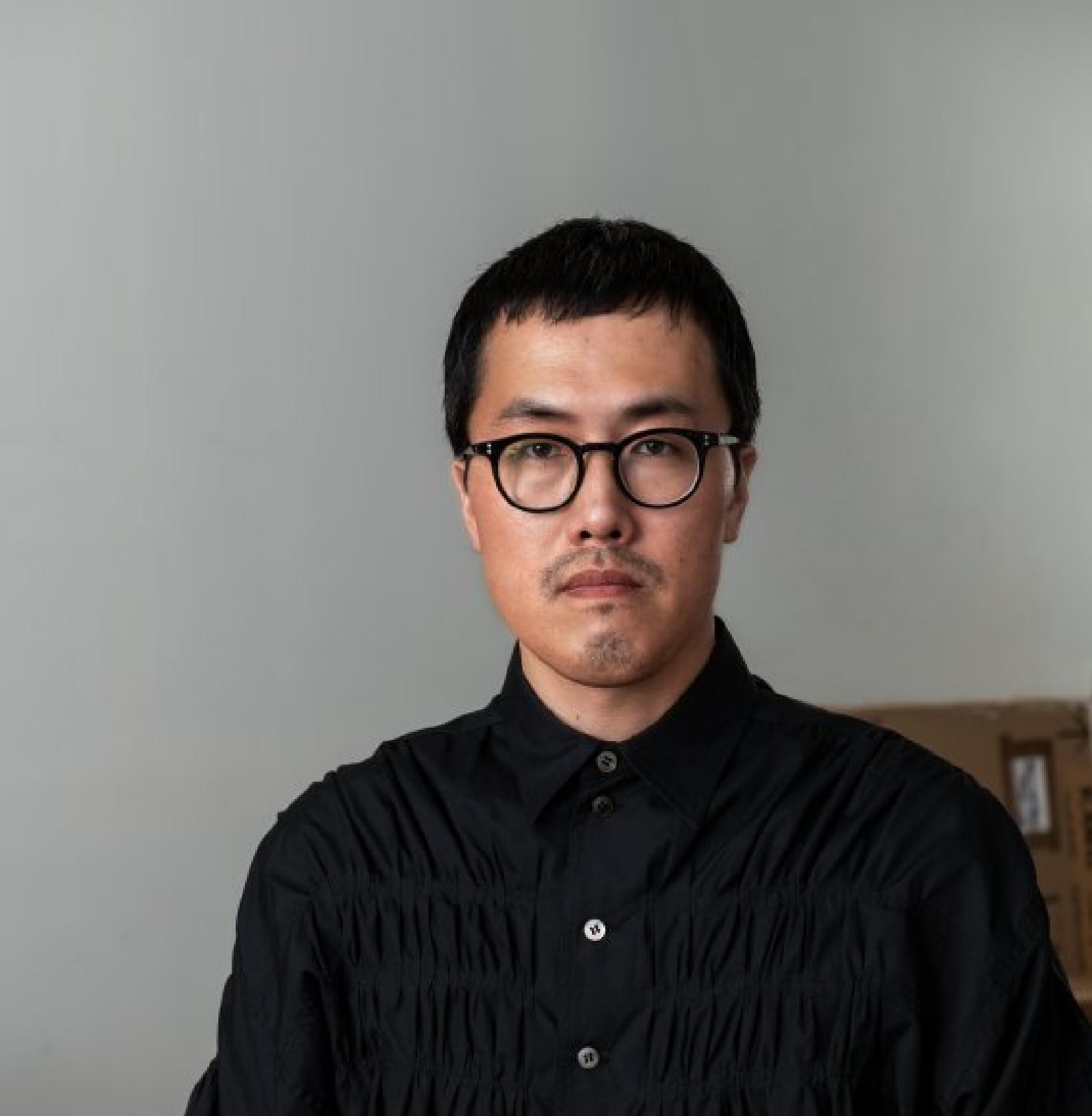 Artist
Kang Seung Lee ©Gallery Hyundai
Artist
Kang Seung Lee ©Gallery HyundaiKang Seung Lee received his M.F.A from the
California Institute of the Arts, USA. Lee has had solo exhibitions at Vincent
Price Art Museum (Los Angeles, 2023), Gallery Hyundai (Seoul, 2021), ONE AND J.
Gallery (Seoul, 2018), Artpace (San Antonio, 2017), Commonwealth and Council (Los
Angeles, 2017, 2016), Los Angeles Contemporary Archive (Los Angeles, 2016),
Pitzer College Art Galleries (Claremont, 2015), Centro Cultural Border (Mexico
City, 2012), and among others.
Lee has exhibited internationally including
at Hammer Museum (Los Angeles, 2023), Palais de Tokyo (Paris, 2023), de Appel (Amsterdam,
2023), Whitney Museum of American Art (New York, 2022), National Museum of
Modern and Contemporary Art Korea (Seoul, 2020), and PARTICIPANT INC (New York,
2019). He has also participated in New Museum Triennial (New York, 2021), and
13th Gwangju Biennial (Gwangju, 2021).
Lee is the recipient of the CCF Fellowship
for Visual Artists (2019), the Rema Hort Mann Foundation grant (2018), and
Artpace San Antonio International Artist-in-Residence program (2017). Lee’s
work is in the collections of Solomon R. Guggenheim Museum, New York; Los
Angeles County Museum of Art, Los Angeles; National Museum of Modern and
Contemporary Art, Korea; The Getty, Los Angeles; among others.
References
- 이강승, Kang Seung Lee (Artist Website)
- 올해의 작가상 2023, 이강승 : “움직임을 불어넣다” - 케이비어 문 (Korea Artist Prize 2023, Kang Seung Lee: “Setting Things in Motion” - Kavior Moon)
- 갤러리현대, 이강승 (Gallery Hyundai, Kang Seung Lee)
- 원앤제이 갤러리, Garden (ONE AND J. Gallery, Garden)
- 합정지구, 퀴어락 (Hapjungjigu, QueerArch)
- 갤러리현대, 잠시 찬란한 (Gallery Hyundai, Briefly Gorgeous)
- 월간미술, Sight & Issue : 이강승 “잠시 찬란한”
- 국립현대미술관, “손의 심장” – 이강승 (National Museum of Modern and Contemporary Art Korea (MMCA), “The Heart of A Hand” – Kang Seung Lee)




